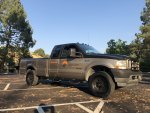Andy, you didn't know that because it isn't true. Ford did no such thing. In fact, Thomas Cavenaugh, a Ford mid level executive who was the Super Duty program manager in the late nineties when the Super Duty was developed, gave an advance drawing to Dudley DeZonia, the owner of Royal Truck Body who manufactured the sculpted utility body, long before the Super Duty was introduced. The drawing was only the side profile, in cross section, not the entire design rendering. Sort of like a clandestine scribble on a napkin... in order to give DeZonia's designers (from Mexico) an idea about how to create the external skin door stampings and fiberglass corner trims. Even then, a design intern at Royal truck ended up softening the lower body crease because it seemed too harsh, as there was no actual Super Duty truck in existence at that time upon which to "copy" the body.
Ford's incentive for giving up the body line profile? So that aftermarket accessories could be available for the truck immediately after launch. Ford not only provided the cut line to Royal Truck... Ford also featured a photo of Royal Sport Dually body in Ford's 1999 RV & Towing Guide, and the same photo was used in other official Ford marketing materials related to towing.
The only "copyright infringement" that Royal Truck body faced with respect to this sculpted body was a legal dispute relating to the body's original name: "Lock 'N Load". That name was already in use by another company (by a lot of folks, actually, because it is a popular idiom of the English language and American western gun culture), and that company took action, so Royal Truck Body had to come up with a new name and destroy all the original brochures (wish I had kept one) with the Lock 'N Load name.
The reasons for discontinuing the manufacture of this sculpted utility body are many, but they have nothing whatsoever with Ford "shutting the manufacture down." The manufacture is still in business, still manufacturing utility bodies. It was the manufacturer's decision to stop production of the sculpted bodies (they produced one for the GM truck as well, called the "Summit"). The bottom line reason was simple. The beds weren't making a profit. Few recreational/personal use buyers were willing to pay $8,000 to $10,000 for the body, which 15 years ago, was a lot more money in a truck than it is today. Commercial buyers couldn't care less about the body lines matching the cab, and for work purposes preferred to have larger enclosed compartments that were taller and wider than the sculpted body could manage and still fit within the cab width and window sill height of a regular pickup bed.
The sculpted body was also doomed by the way it was distributed. A separate company, called ABC Body, was used to distribute the bodies throughout the United States. Since the body wasn't commercial, it didn't make sense to paint the bodies all white, because the color choice of the private customer might be Woodland Green, or Prairie Tan, or Denim Blue, or Ebony (mine). So the bodies were shipped UNPAINTED by rail car from California (where they were made) to a holding yard in Kentucky (where the Super Duty was made), and the North East (forgot what state). ABC contracted with other body companies in these locations to paint and mount the bodies as orders (which were few and far between) came in for them. Well, while the bodies sat unpainted, waiting for customer orders, they began to corrode. But, they got painted anyway. Then, the customer would find rust perforation in short order, and then Royal Truck Body would get stuck with the warranty cost to replace or repair the body.
When I last visited the manufacturing plant in California back in 2002, there was a grave yard of rusted sculpted bodies stacked two and three high on top of each other. Royal was cannibalizing those corroded bodies for parts, to repair or build new sculpted bodies. Business wasn't getting any better for this line in the following year, as the US entered into the first of two wars waged in this century, and fuel prices were beginning to climb. The final chapter in the life of this sculpted body came in the form of a plant fire that burned the tooling that was dedicated to making it. What is interesting about this fire is that just a year or two prior, Dudley DeZonia had invested a huge amount of money in plant upgrades to make these bodies. There was some reported speculation that the plant fire was allegedly set on purpose, for the insurance proceeds to recover from this bad business investment. There is no way to really know what happened, other than these bodies are not made anymore, and that Royal Truck, who was granted a patent on various aspects of the design, allowed the patent to expire.


















